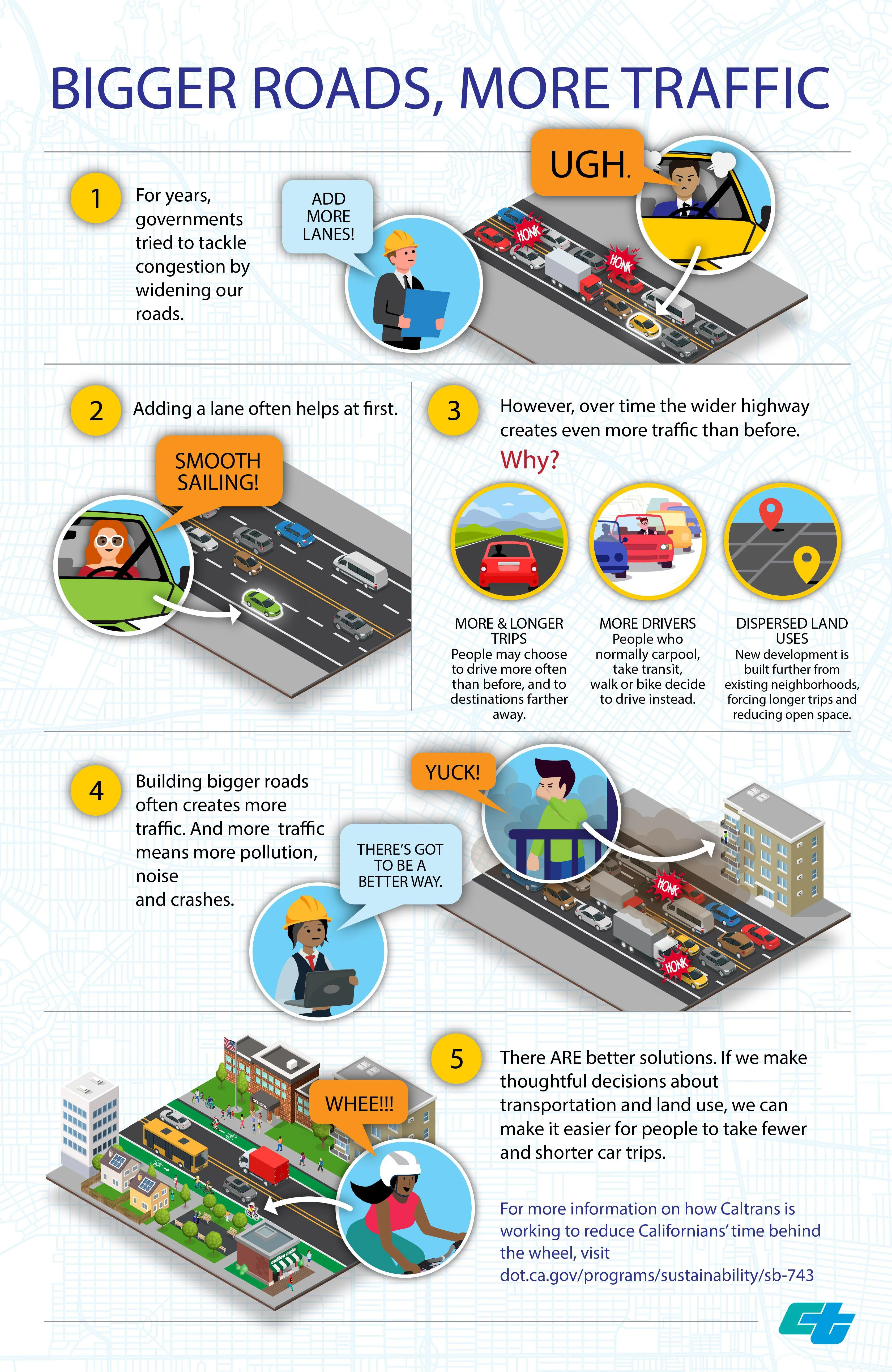We could solve traffic by adding more lanes.
This is a short term solution. There is a term called induced demand where the better the infrastructure, the more that people will use it. What this will mean is that in 3 years, traffic will resume to bad or worse.
Resources
Traffic Jam? Blame ‘Induced Demand.’ - Bloomberg
https://www.bloomberg.com/news/articles/2018-09-06/traffic-jam-blame-induced-demand
- https://usa.streetsblog.org/2020/03/11/america-is-spending-billions-just-to-make-traffic-worse/
- https://www.reddit.com/r/chicago/comments/rb2lad/chicago_drivers_lost_104_hours_sitting_in_traffic/
- https://www.reddit.com/r/fuckcars/comments/rbjndz/cars_literally_wasting_more_than_half_a_week_in_a/
Exact quote?
Just as with the Katy Freeway expansion, adding new roadway capacity also creates new demand for those lanes or roads, maintaining a similar rate of congestion, if not worsening it.
A lot of numbers in the first referrer article. $500 billion dollars was used to build those highways where you could have built a subway line 111 times over. Maintenance also costs $5 billion per year. There is also a text at the end where some mayor said adding highways would lead to greater economic activity. But there’s a finding that contradicts this but I couldn’t find that study.
Why Widening Highways Doesn’t Bring Traffic Relief - Bloomberg
- https://www.reddit.com/r/chicago/comments/rb2lad/chicago_drivers_lost_104_hours_sitting_in_traffic/
- https://www.reddit.com/r/fuckcars/comments/rbjndz/cars_literally_wasting_more_than_half_a_week_in_a/
Reducing congestion: Katy didn’t | City Observatory
https://cityobservatory.org/reducing-congestion-katy-didnt/
- https://www.reddit.com/r/comics/comments/rgayyc/add_cars_to_the_list_of_things_i_cant_draw_lol/honf1bo/
- https://reddit.com/r/fuckcars/comments/u9hks1/american_tax_money_will_be_going_to_cars_and/i5rppgp/
The Katy Freeway in Houston had gotten worse after adding more lanes.
Highway 401 in Toronto : UrbanHell
https://www.reddit.com/r/UrbanHell/comments/rk1ize/highway_401_in_toronto/
https://www.reddit.com/r/fuckcars/comments/rk3zsy/highway_401_in_toronto/
This is a photo of a highway in Toronto. The comments said that this photo is quite old. It’s much worse now.
A Lesson on Induced Demand | Why Your Public Transit Matters - YouTube - Yet Another Urbanist
https://www.youtube.com/watch?v=_rnbgIrf-wE
https://www.reddit.com/r/fuckcars/comments/rm6smx/i_started_a_channel_about_urban_planning_car/
The title of this YouTube video is about induced demand but he actually acknowledges all the issues. how public transport can solve. You can see it at 12:56.
At 3:26, he listed out all the costs of maintaining the roads in Reno.
At 6:48, he showed a diagram on how each transportation mode carries people with cars being the lowest and dedicated transit lanes is the highest.
At 7:17, he explained the Downs-Thomson paradox in Layman’s terms which is
if your bus is stuck in traffic, so is everyone else
Why Traffic Is So Bad In Los Angeles - YouTube - CNBC
https://www.youtube.com/watch?v=S76lKWeU_xc
- https://www.reddit.com/r/fuckcars/comments/rtokuj/why_traffic_is_so_bad_in_los_angeles/
- https://www.reddit.com/r/fuckcars/comments/ru37p8/ehhh_just_watched_this_video_what_do_you_guys/
He talked about induced demand at 7:53.
What People Get Wrong About Induced Demand - YouTube - Oh The Urbanity!
https://www.youtube.com/watch?v=8wlld3Z9wRc
Induced demand applies to all modes of transportation. But increasing demand for cars brings a lot more problems than other modes of transportation.
A good quote at the end of the video:
The question isn’t really which types of transportation infrastructure induce demand because they all do. The question is which type of demand you want to induce.
The Science Is Clear: More Highways Equals More Traffic. Why Are DOTs Still Ignoring It? – Streetsblog USA
From the article,
They found that for every 1 percent increase in highway capacity, traffic increases 0.29 to 1.1 percent in the long term (about five years out), and up to 0.68 percent in the short term (one or two years). One recent study found a one-to-one relationship between new highway lane capacity and traffic increases.
Hence, adding new lanes is never a good long term solution.
How highways make traffic worse - YouTube - Vox
https://www.youtube.com/watch?v=2z7o3sRxA5g
When Houston added more lanes to their Katy Freeway, traffic got worse.
What’s Up With That: Building Bigger Roads Actually Makes Traffic Worse | WIRED
https://www.wired.com/2014/06/wuwt-traffic-induced-demand/
They found that:
If a city had increased its road capacity by 10 percent between 1980 and 1990, then the amount of driving in that city went up by 10 percent. If the amount of roads in the same city then went up by 11 percent between 1990 and 2000, the total number of miles driven also went up by 11 percent. It’s like the two figures were moving in perfect lockstep, changing at the same exact rate.
it is a one-to-one relationship.
Other ways to reduce traffic is to introduce congestion pricing and reducing free parking.
The World’s Widest Highway Spans a Whopping 26 Lanes | Condé Nast Traveler
https://www.cntraveler.com/story/the-worlds-widest-highway-spans-a-whopping-26-lanes
After the widening of the Katy Freeway, morning and evening travel times along the route actually increased by 30 and 55 percent, respectively.
Please stop adding more lanes to busy highways—it doesn’t help | Ars Technica
https://arstechnica.com/cars/2021/08/please-stop-adding-more-lanes-to-busy-highways-it-doesnt-help/
More Lanes Do Not Mean Less Traffic - RMI
https://rmi.org/more-lanes-do-not-mean-less-traffic/
Adding lanes doesn’t reduce congestion. So what is TxDOT doing?
Why adding more lanes doesn’t reduce traffic jams | The Spokesman-Review
What Dallas, Houston, Louisville & Rochester can teach us about widening freeways: Don’t!
America’s largest freeway is Houston’s 23-lane Katy Freeway. Its been widened many times, always, ostensibly with the idea of eliminating congestion. But no matter how wide it gets, added capacity just induces further flung development and more peak hour driving, with the result that the freeway is even slower today than it was when it was widened just a few years ago. Texas spent $2.3 billion to widen the road, but just three years after in opened, the morning commute has increased by 25 minutes (or 30 percent) and the afternoon commute has increased by 23 minutes (or 55 percent).
Expanding highways and building more roads actually makes traffic worse - Curbed
https://archive.curbed.com/2020/3/6/21166655/highway-traffic-congestion-induced-demand
The nation’s largest 100 urban areas added 30,511 new lane-miles of roads between 1993 and 2017, according to the report, a 42 percent increase (and a trend that shows no signs of slowing down). For perspective, that’s higher than population growth, which was 32 percent in those metros over the same time period. That’s not all that grew: traffic congestion, as measured in annual hours of delay, actually rose during those 24 years, by a staggering 144 percent.
In Pensacola, Florida, and Omaha, Nebraska—which both saw highways expand three times faster than population growth—congestion increased by 233 and 231 percent, respectively. In booming Boise, Idaho, roads expanded 141 percent while population grew 117 percent. But congestion increased 446 percent.
Rethinking How We Build So Californians Can Drive Less | Caltrans
https://dot.ca.gov/programs/sustainability/sb-743
